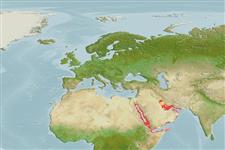Classification / Names
Common names from other countries
Main reference
Size / Weight / Age
Max length : 35.0 cm TL male/unsexed; (Ref. 5222); common length : 23.0 cm TL male/unsexed; (Ref. 5450); max. reported age: 26 years (Ref. 1784)
Environment
Marine; reef-associated; non-migratory; depth range 4 - 55 m (Ref. 5222), usually 15 - 20 m (Ref. 89707)
Climate / Range
Tropical, preferred 26°C (Ref. 107945); 33°N - 10°N, 32°E - 66°E (Ref. 5222)
Distribution
Western Indian Ocean: only from the northern end of the Red Sea to the Persian Gulf and coast of Pakistan. Records from elsewhere are apparently based on misidentifications of other species. Misidentified as Cephalopholis miniatus by Kuronuma & Abe (1986, Ref. 5999) from Kuwait.
Countries | FAO areas | Ecosystems | Occurrences | Introductions
Short description
Dorsal
spines
(total): 9;
Dorsal
soft rays
(total): 8-10;
Anal
spines: 3;
Anal
soft rays: 8 - 10. distinguished by the following characteristics: body depth 2.7-3.0 in SL; head length 2.4-2.6 in SL; flat interorbital area; rounded preopercle, finely serrate, lower edge fleshy; distinctly convex upper edge of operculum; scaly maxilla, reaching to or somewhat beyond vertical at rear edge of eye; ctenoid body scales, without auxiliary scales (Ref. 089707).
IUCN Red List Status (Ref. 115185)
Threat to humans
Harmless
Human uses
Fisheries: subsistence fisheries
More information
ReferencesAquacultureAquaculture profileStrainsGeneticsAllele frequenciesHeritabilityDiseasesProcessingMass conversion
Tools
Special reports
Download XML
Internet sources
Estimates of some properties based on models
Phylogenetic diversity index
PD50 = 0.5000 many relatives (e.g. carps) 0.5 - 2.0 few relatives (e.g. lungfishes)
Trophic Level
4.1 ±0.6 se; Based on diet studies.
Resilience
Low, minimum population doubling time 4.5 - 14 years (K=0.11)
Vulnerability
High vulnerability (58 of 100)
Price category
